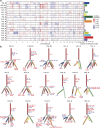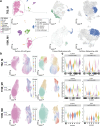Treatment resistance to melanoma therapeutics on a single cell level
- PMID: 39300183
- PMCID: PMC11413001
- DOI: 10.1038/s41598-024-72255-9
Treatment resistance to melanoma therapeutics on a single cell level
Abstract
Therapy targeting the BRAF-MEK cascade created a treatment revolution for patients with BRAF mutant advanced melanoma. Unfortunately, 80% patients treated will progress by 5 years follow-up. Thus, it is imperative we study mechanisms of melanoma progression and therapeutic resistance. We created a scRNA (single cell RNA) atlas of 128,230 cells from 18 tumors across the treatment spectrum, discovering melanoma cells clustered strongly by transcriptome profiles of patients of origins. Our cell-level investigation revealed gains of 1q and 7q as likely early clonal events in metastatic melanomas. By comparing patient tumors and their derivative cell lines, we observed that PD1 responsive tumor fraction disappears when cells are propagated in vitro. We further established three anti-BRAF-MEK treatment resistant cell lines using three BRAF mutant tumors. ALDOA and PGK1 were found to be highly expressed in treatment resistant cell populations and metformin was effective in targeting the resistant cells. Our study suggests that the investigation of patient tumors and their derivative lines is essential for understanding disease progression, treatment response and resistance.
© 2024. The Author(s).
Conflict of interest statement
The authors declare no competing interests.
Figures




References
-
- Larkin, J. et al. Combined vemurafenib and cobimetinib in BRAF-mutated melanoma. N. Engl. J. Med.371, 1867–1876 (2014). - PubMed
-
- Long, G. V. et al. Adjuvant Dabrafenib plus Trametinib in stage III BRAF-mutated melanoma. N. Engl. J. Med.377, 1813–1823 (2017). - PubMed
-
- Robert, C. et al. Five-year outcomes with Dabrafenib plus Trametinib in metastatic melanoma. N. Engl. J. Med.381, 626–636 (2019). - PubMed
MeSH terms
Substances
Grants and funding
LinkOut - more resources
Full Text Sources
Medical
Research Materials
Miscellaneous

